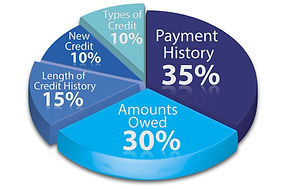Increasing Scores One Bureau at a Time
Mission: Empower the community with equity knowledge and skills to strengthen personal financial responsibility and growth.
Credit: Is now a necessity, a critical part of life. It is important because it signifies a community's belief in the financial status of the individual. Without credit, it is almost impossible to obtain the things you want in life.
Debt: There is no debtor’s prison if you cannot pay your bills. Many people are burden with debt and face economic challenges. If an individual is in financial ruin, there is a remedy.
What is a Credit Score?
A credit score is a number based on information contained in your credit report. You don’t have just one credit score. There are many credit scoring formulas, and the score will also depend on the data used to calculate it.
Remove
-
Collections
-
Repossessions
-
Late payments
-
Closed accounts
-
Bankruptcy
-
Hard inquires
-
Charge-offs
-
Evictions
-
Medical bills

Lenders use these reports to help them decide if they will loan you money, and at what interest rate. Credit reporting agencies (also known as credit reporting companies or credit bureaus) compile these reports. Credit scores are calculated using a mathematical formula—called a scoring model—that companies and lenders use to predict how likely you are to pay back a loan on time. Your credit scores are calculated from the information in your credit report.
Remember: The higher your FICO score, the easier it will be for you to qualify for the credit you want at the best interest
How your score is calculated:
Ultimately, the credit bureaus take all the information from these five categories and use complicated algorithms to arrive at your final credit scores. To start, here are the five factors that go into calculating your credit score:
1. Payment history: The record that demonstrates whether or not you make timely payments on your account. It accounts for 35% of your credit score.
2. Credit utilization: The percentage of your available credit you have used. Our credit score looks at your overall debt and credit use — the ratio of your credit balance to your credit limit A lower ratio is better. This accounts for 30% of your credit score.
3. Age of credit: How long you’ve had credit and how old your accounts are. Your credit score considers how long you’ve had credit and how long your accounts have been open and how long since your accounts have had activity. It accounts for 15% of your credit score.
4. New Credit: How many times you have applied for various forms of credit in the past two years. Opening multiple accounts in a short span of time represents greater risk. It is it's important to be strategic when shopping for a new loan or credit card since you don't want your report to show you're constantly applying for credit. This accounts for the last 10% of your credit score.
5. Credit Mix: The diversity of your credit mix. Your credit score also considers the different types of credit accounts you have credit cards, retail accounts, installment loans, finance company accounts and mortgage loans. This accounts for 10% of your credit score.
